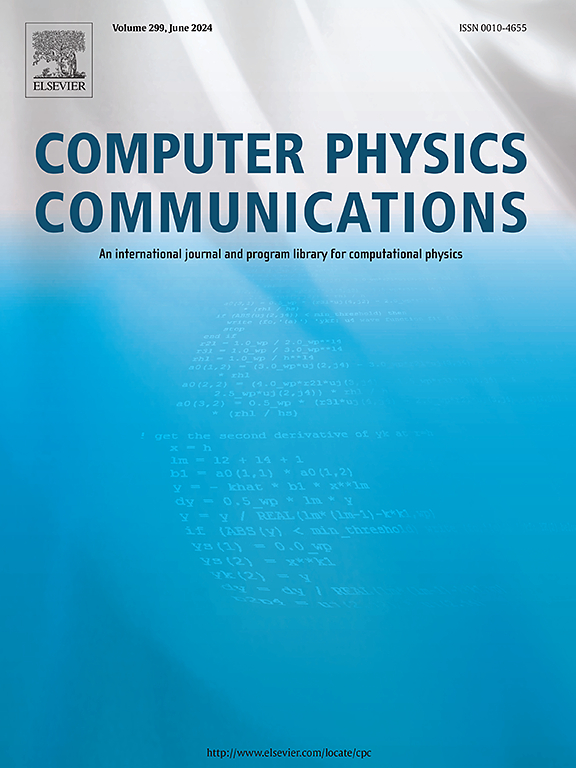VAN-DAMME:多量子比特系统的 GPU 加速和对称辅助量子优化控制
IF 7.2
2区 物理与天体物理
Q1 COMPUTER SCIENCE, INTERDISCIPLINARY APPLICATIONS
引用次数: 0
摘要
我们介绍了一个开源软件包 VAN-DAMME(数值设计、加速和操纵磁激发的多功能方法),用于多量子比特系统的大规模并行量子优化控制(QOC)计算。为了实现大型 QOC 计算,VAN-DAMME 软件包利用了基于对称性的技术和定制的 GPU 增强算法。这种组合方法可以同时计算数百个矩阵指数传播者,有效利用高性能 GPU 中的 GPU 内部并行性。此外,为了最大限度地提高 VAN-DAMME 代码的计算效率,我们对数据布局、计算复杂性、内存需求和性能进行了多次广泛测试。通过这些广泛的分析,我们开发出了计算效率高的方法,用于评估基于帕代近似值的复值矩阵指数传播者。为了评估我们的GPU加速VAN-DAMME代码的计算性能,我们对包含10-15个量子比特的系统进行了QOC计算,结果表明我们的GPU实现比相应的CPU实现快18.4倍。我们的GPU加速增强技术可以实现多量子比特系统的高效计算,可用于跨多个领域的QOC应用的高效实施:VAN-DAMMECPC 程序库链接到程序文件:: https://doi.org/10.17632/zcgw2n5bjf.1Licensing provisions:GNU General Public License 3编程语言:问题性质:VAN-DAMME 软件包利用 GPU 加速例程和新的算法改进来计算优化的随时间变化的磁场,该磁场可以驱动一个系统从已知的初始量子比特配置以大(≈1)的过渡概率到达指定的目标状态:量子控制、GPU 加速、解析梯度、矩阵指数和梯度上升优化。本文章由计算机程序翻译,如有差异,请以英文原文为准。

VAN-DAMME: GPU-accelerated and symmetry-assisted quantum optimal control of multi-qubit systems
We present an open-source software package, VAN-DAMME (Versatile Approaches to Numerically Design, Accelerate, and Manipulate Magnetic Excitations), for massively-parallelized quantum optimal control (QOC) calculations of multi-qubit systems. To enable large QOC calculations, the VAN-DAMME software package utilizes symmetry-based techniques with custom GPU-enhanced algorithms. This combined approach allows for the simultaneous computation of hundreds of matrix exponential propagators that efficiently leverage the intra-GPU parallelism found in high-performance GPUs. In addition, to maximize the computational efficiency of the VAN-DAMME code, we carried out several extensive tests on data layout, computational complexity, memory requirements, and performance. These extensive analyses allowed us to develop computationally efficient approaches for evaluating complex-valued matrix exponential propagators based on Padé approximants. To assess the computational performance of our GPU-accelerated VAN-DAMME code, we carried out QOC calculations of systems containing 10 - 15 qubits, which showed that our GPU implementation is 18.4× faster than the corresponding CPU implementation. Our GPU-accelerated enhancements allow efficient calculations of multi-qubit systems, which can be used for the efficient implementation of QOC applications across multiple domains.
Program summary
Program Title: VAN-DAMME
CPC Library link to program files:: https://doi.org/10.17632/zcgw2n5bjf.1
Licensing provisions: GNU General Public License 3
Programming language: C++ and CUDA
Nature of problem: The VAN-DAMME software package utilizes GPU-accelerated routines and new algorithmic improvements to compute optimized time-dependent magnetic fields that can drive a system from a known initial qubit configuration to a specified target state with a large (≈1) transition probability.
Solution method: Quantum control, GPU acceleration, analytic gradients, matrix exponential, and gradient ascent optimization.
求助全文
通过发布文献求助,成功后即可免费获取论文全文。
去求助
来源期刊

Computer Physics Communications
物理-计算机:跨学科应用
CiteScore
12.10
自引率
3.20%
发文量
287
审稿时长
5.3 months
期刊介绍:
The focus of CPC is on contemporary computational methods and techniques and their implementation, the effectiveness of which will normally be evidenced by the author(s) within the context of a substantive problem in physics. Within this setting CPC publishes two types of paper.
Computer Programs in Physics (CPiP)
These papers describe significant computer programs to be archived in the CPC Program Library which is held in the Mendeley Data repository. The submitted software must be covered by an approved open source licence. Papers and associated computer programs that address a problem of contemporary interest in physics that cannot be solved by current software are particularly encouraged.
Computational Physics Papers (CP)
These are research papers in, but are not limited to, the following themes across computational physics and related disciplines.
mathematical and numerical methods and algorithms;
computational models including those associated with the design, control and analysis of experiments; and
algebraic computation.
Each will normally include software implementation and performance details. The software implementation should, ideally, be available via GitHub, Zenodo or an institutional repository.In addition, research papers on the impact of advanced computer architecture and special purpose computers on computing in the physical sciences and software topics related to, and of importance in, the physical sciences may be considered.
 求助内容:
求助内容: 应助结果提醒方式:
应助结果提醒方式:


